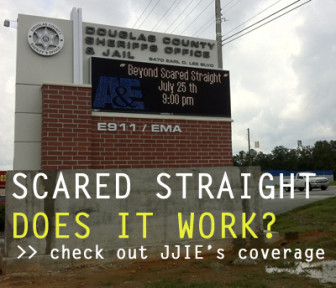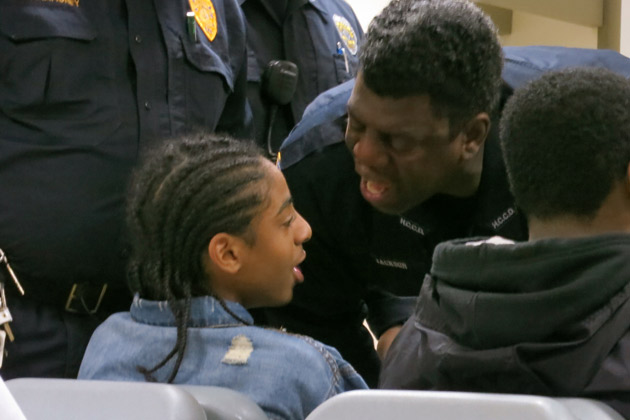The controversial A&E Network series “Beyond Scared Straight” returns August 20 for a third season. If this 30-second teaser from A&E is any indication, viewers can expect more episodes filled with inmates and prison guards yelling at, verbally abusing and intimidating at-risk teens, with the apparent goal of creating “powerful experiences” that “break down walls” so that “kids will listen,” according to the video.
But while the television show may be enormously popular with viewers – in 2011 receiving A&E’s highest ratings ever for a series premier – experts nearly unanimously agree that Scared Straight-style programs create higher incidences of recidivism and do more harm than good for teens, and they can point to nearly 30 years of research as evidence.
“It is more likely to create kids who are going to get in trouble,” Joe Vignati, national juvenile justice specialist on the Executive Board of the Coalition for Juvenile Justice, told JJIE in January 2011, when the series first premiered.
 In a 2000 report by Anthony Petrosino, Carolyn Turpin-Petrosino and James O. Finckenauer that examines the effectiveness of Scared Straight-style programs, the authors write, “Few programs were as popular or well intentioned as Scared Straight. Yet, despite such popularity and benevolence, there is little evidence to suggest that the program is a deterrent to subsequent juvenile crime and delinquency. In contrast, the evidence strongly suggests that it leads to more crime by program participants.” In fact, the study found that Scared Straight-style programs increased crime between 1 percent and 28 percent in experimental groups when compared to groups who did not participate in similar programs.
In a 2000 report by Anthony Petrosino, Carolyn Turpin-Petrosino and James O. Finckenauer that examines the effectiveness of Scared Straight-style programs, the authors write, “Few programs were as popular or well intentioned as Scared Straight. Yet, despite such popularity and benevolence, there is little evidence to suggest that the program is a deterrent to subsequent juvenile crime and delinquency. In contrast, the evidence strongly suggests that it leads to more crime by program participants.” In fact, the study found that Scared Straight-style programs increased crime between 1 percent and 28 percent in experimental groups when compared to groups who did not participate in similar programs.
Based in part on these studies, the federal Office of Juvenile Justice and Delinquency Prevention (OJJPD) “discouraged” the use of Scared Straight-style programs.

A scene from the 3rd season of 'Beyond Scared Straight," courtesy A&E
But Scared Straight programs remain popular because “they fit with common notions by some on how to prevent or reduce crime (by 'getting tough')” and because “they are very inexpensive (a Maryland program was estimated to cost less than $1 U.S. per participant),” according to a second report authored by Petrosino, Turpin-Petrosino and John Buehler and most recently updated in November 2004.
So if Scared Straight doesn’t work what are the alternatives?
Research suggests mentoring may be the best option, according to an op-ed by Jeff Slowikowski, then the acting OJJDP administrator, and Laurie Robinson, assistant attorney general for the Office of Justice Programs, published by The Baltimore Sun in February 2011.
“Mentoring programs have been found to be effective in reducing incidents of delinquency, substance use and academic failure in participating youth,” they wrote. “Research has shown that mentoring relationships that last at least 12 months or through an entire school year are most effective. Further, youth in long-term mentoring relationships tend to improve their self-esteem, social skills and outlook about their future.”
Among mentoring programs for youth, the most well known may be Big Brothers Big Sisters. But other programs focus on specific populations of youth. We Stand for Kids, for example, works with the children of incarcerated adults with the hope of ending the cycle of incarceration.
Contact with inmates or offenders isn’t always negative, however, according to research by Phillip D. Holley and Dennis Brewster. The Oklahoma Department of Corrections (ODOC) instituted a program called “Speak Out” that takes offenders directly to the kids in schools or churches. Speaking about their own experiences, the offenders “attempt to inform community youth/parents/adults, etc. about the evils of crime, gang involvement, and life in prison,” according to the study, and to do so without the intimidation of typical Scared Straight-style programs.
A similar program in Texas known as Operation Kick-It brings inmates – dressed in their white prison jumpsuits – to high schools and to meet with other groups to speak to at-risk youth without the “audience intimidation and scare tactics,” according to Holley and Brewster. It is estimated the groups of inmates make more than 1,000 appearances a year and have spoken with between 200,000 and 300,000 youth since the program’s inception.
According to Strategies for Youth, effective youth programs should:
- Provide large amounts of meaningful contact
- Have a longer duration
- Be “designed by a researcher or have research as an influential component of the treatment setting”
- Offer behavioral, skill-oriented and multi-modal treatment
- Be gender-specific and sensitive
Click here for JJIE’s complete coverage of “Beyond Scared Straight.”
http://jjie.org/oped-joe-vignati-on-beyond-scared-straight-irresponsibility-of-ae-network/20182
http://jjie.org/joe-vignatibeyond-scared-straight-beyond-common-sense/8684
It is absurd to have a show on because the public views it as good television. I did a report on effective intervention strategies and not only is Scared Straight ineffective but some reports actually document that it adds to the delinquency problems with adolescents. Why is a show like this allowed to be aired. I also have to question the parents that send their children to this because it can cause much harm to the child and the parent does not learn any techniques for dealing with their children. This show needs to be banned!
I wonder why such programs would actually cause more delinquency? Perhaps overconfidence can be an issue, making them think that “only dumb criminals get caught.” Since most people think they’re smarter than average, combined with the fact that many youth feel invulnerable, they’d likely conclude that they’d never get caught.
For some guys, seeing the horrors of prison might increase the thrill of risk – like showing the dark side of extreme sports might motivate some people rather than induce caution.
I’m just guessing here, but it seems worth exploring.
I was wondering the same thing. Why is that info not in the article? JJIE and Schill: please clarify this in the next issue.
The “why” question is addressed beginning on page 31 here: http://youthtoday.org/doc/CC%20Scared%20Straight%20research.pdf
Their answer is unsatisfying as more research needs to be done on the subject.
“It’s what the public wants” and the media guys play to the lowest common denominator. It’s cheap, it’s nasty, and, guess what, it doesn’t work. When ever did pandering to the worst in people make a positive difference. No way will the makers tell us their program is shit, aimed more at ratings and gratifying the nastiest instincts in folk – they want to see the system get tough, so viewers can get their rocks off watching kids humiliated and abused. Legislators surprised? They are the first to jump on bandwagons, eager to play to the law and order gallery, because most of them haven’t a brain cell so can’t work out these ideas are crap before they praise them. Maybe they should be on a program to scare them straight, preferably in not standing for election, or in resigning before they harm people. Now THAT’s a show I could watch. There are ideas that do work, but most of them aren’t popular because they might involve being nice to kids and empathic. That doesn’t mean no discipline, at best it means teaching self-discipline, getting kids to resist any attraction in misbehaviour and crime for themselves.